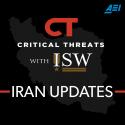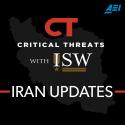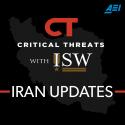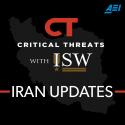Iran Update, May 5, 2023
May 5, 2023 - ISW PressIran Update, May 5, 2023
Annika Ganzeveld, Johanna Moore, Amin Soltani, and Kitaneh Fitzpatrick
May 5, 2023, 4:00 pm ET
Iran Update, May 5, 2023
Annika Ganzeveld, Johanna Moore, Amin Soltani, and Kitaneh Fitzpatrick
May 5, 2023, 4:00 pm ET

The Iranian regime is seeking to take advantage of political and economic developments in Syria and Iraq to improve the Iranian economy and advance its strategic goals in the region. Various Raisi administration ministers met with Syrian officials on May 4. Economic and Financial Affairs Minister Ehsan Khandouzi announced the “removal of obstacles” to Iranian export companies operating in Syria following a meeting with several Syrian economic officials. Information and Communications Technology Minister Issa Zare Pour separately signed a cooperation agreement with his Syrian counterpart, Iyad al Khatib, to facilitate Iranian involvement in modernizing Syria’s telecommunications infrastructure. Zare Pour additionally emphasized Iranian satellites’ ability to produce high-resolution images that Syrian officials can use in agriculture, infrastructure, and construction. Defense and Armed Forces Logistics Minister Mohammad Reza Ashtiani and Roads and Urban Development Minister Mehrdad Bazrpash also accompanied Raisi to Damascus. Ashtiani likely sought to secure weapons sales while Bazrpash likely discussed plans with Syrian officials to establish a rail link between Iran and Syria.
Iranian President Ebrahim Raisi signed 15 cooperation agreements with Syrian President Bashar al Assad in Damascus, Syria on May 3, which could improve the Iranian economy and increase regime stability. Raisi signed these agreements on the first of his two-day trip to Syria, the first trip an Iranian president has made to Syria since the start of the Syrian civil war in 2011 and Arab Spring. Raisi and Assad signed several memorandums of understanding covering oil, energy, transportation, reconstruction, and communications technology. Raisi also asserted that Iranian companies are prepared to be the primary providers of reconstruction projects in Syria during an interview with Lebanese Hezbollah-run Al Mayadeen on May 2. The head of the Iran-Syria Joint Economic Commission and Iran’s Roads and Urban Development Minister Mehrdad Bazrpash separately announced on May 3 that the commission established a joint Iranian-Syrian bank to facilitate business transactions between the two countries. The commissioner’s announcement of the joint bank while Iran and Syria signed economic cooperation agreements suggests the bank will have a role in funding Iranian reconstruction projects in Syria and transferring payments to Iran. These payments would increase capital inflow to Iran, which would help reinvigorate Iran’s deteriorating economy. The role of Iranian para-statal organizations in generating revenue through Syria’s reconstruction would not alleviate Iran’s high inflation and unstable currency, although the regime may attempt to frame it as such to the Iranian people. Such para-statal organizations include the Khatam al Anbia Construction Headquarters, which is the IRGC’s engineering and development firm that oversees large-scale civil-military construction projects and helps the regime circumvent sanctions.

Iranian officials and members of the clerical establishment have expressed increased concern over the safety of religious figures in recent days. Former Intelligence and Security Minister and Shia cleric Hojjat ol Eslam Ali Fallahian called on Friday prayer leaders to learn self-defense during an interview with reformist news outlet Entekhab on May 2. The Islamic Propaganda Coordination Council—a regime body responsible for organizing official ceremonies and public events—separately issued a statement on May 2 urging law enforcement and security services to decisively confront "thugs." The council issued this statement in response to the killing of Assembly of Experts member Ayatollah Abbas Ali Soleimani on April 26. The council chairman—Mohammad Hossein Musa Pour—is a cleric and former governor of Qom City, Qom Province. Law Enforcement Commander Brigadier General Ahmad Reza Radan additionally discussed Soleimani’s murder with Qom Friday Prayer Leader Ayatollah Mohammad Saedi on April 29, possibly to discuss measures to protect clerics.

Iranian leadership dismissed several economic officials and emphasized fighting corruption between April 27 and May 1 to improve Iran’s economy, which is very unlikely to precipitate the meaningful economic change necessary to curb inflation and stabilize the Iranian rial. Supreme Leader Ali Khamenei called on parliament and the Raisi administration to fight economic corruption during a meeting with workers, labor organization members, and Raisi administration officials on April 29. President Ebrahim Raisi has engaged in numerous symbolic economic engagements in recent days. Raisi dismissed 15 unspecified managers in Khuzestan Province to demonstrate his administration’s “intolerance” of corruption during a two-day trip to this province on April 27-28. Raisi additionally ordered the formation of a working group on April 30 to “follow up on the issues” raised by Khamenei in his April 29 meeting with workers without providing further details. Raisi called on his administration to address the needs of contract workers and retirees—who have organized widespread strikes and protests in recent weeks—during a MAPNA Company event for International Workers’ Day on May 1.

President Ebrahim Raisi will visit Damascus on April 3 to initiate several economic projects, possibly to reinvigorate Iran’s economy by securing resources outside of Iran. Reuters reported on April 28 that Raisi will visit Syria on May 3 for a two-day trip, citing an informed source. An Iranian president has not visited Syria since 2011, when the Syrian civil war commenced. The source stated that the recent Iran-Saudi rapprochement and dialogue between Syria and other Arab states prompted the visit. The Lebanese Hezbollah (LH)-affiliated news outlet Al Akhbar reported that Raisi’s two-day visit would result in several economic agreements. An unidentified source cited by Al Akhbar claimed that Raisi’s visit is a part of a larger effort to broaden the Axis of Resistance’s activities beyond its current military activity. Iranian Roads and Urban Development Minister Mehrdad Bazarpash announced on April 25 that Iran intends to connect trade through Iran, Iraq, and Syria via a rail link to reduce tariffs and facilitate banking exchanges during a multi-day visit to Damascus. Bazarpash reported on April 26 that the Iranian-Syrian Joint Economic Forum established eight new committees focused on Iranian investment, energy, and electricity. Iran has cancelled previous economic projects in Syria, including the construction of two power stations on March 13, because the Assad regime sought to pay for the project in raw phosphate.

The domestic Iranian information space is currently shaped such that violence against religious figures is being viewed as part of escalating tensions between the public and Iranian regime. Iranian social media users circulated a video of an unidentified car driver seemingly trying to run over a cleric in Tehran City, Tehran Province on April 27. This incident follows a bank security guard killing Assembly of Experts member Ayatollah Abbas Ali Soleimani in Babolsar, Mazandaran Province on April 26. Many social media users have connected these incidents, arguing that the relationship between regime dissidents and loyalists has become more tense and sensitive in recent months. The driver’s motive for attempting to run over the cleric on April 27 remains unclear. It is possible that the driver deliberately attempted to harm the cleric out of frustration toward the regime. The driver’s decision to attack the cleric is noteworthy regardless of the motive given the extent to which the killing of Ali Soleimani captured the national attention the day prior.

An unidentified man shot and killed Shia cleric and Assembly of Experts member Ayatollah Abbas Ali Soleimani in a bank in Babolsar, Mazandaran Province on April 26. The assailant was a bank security guard who intentionally targeted Soleimani, although his motive remains unclear. Soleimani most recently represented Sistan and Baluchistan in the Assembly of Experts--the regime body responsible for selecting the supreme leader. Soleimani previously served as the Friday prayer leader of Kashan, Esfahan Province and Zahedan, Sistan and Baluchistan Province between 2001 and 2022. Soleimani oversaw Sunni affairs during his tenure as Zahedan Friday Prayer Leader. Soleimani’s connections to the historically restive Sistan and Baluchistan Province are noteworthy following heightened tensions between Iranian officials and Sistan and Baluchistan residents in recent months.
Qom Provincial Governor Mohammad Taghi Shah Cheraghi stated that the provincial government should take “negative measures” against unveiled women “in accordance with the law” during a 19 Dey Headquarters meeting on April 25. The 19 Dey Headquarters is an organization dedicated to preserving Qom’s status as Iran’s religious and revolutionary heartland. This organization met on April 25 to discuss the actions it has taken in the field of chastity and hijab. Regime officials have increasingly discussed using “positive” and “negative” measures to enforce the mandatory hijab law in recent weeks, although it is unclear what they mean exactly when using these terms.

Supreme Leader Ali Khamenei briefly lost control of his audience during a speech to Basij students on April 18, indicating the degree to which dissatisfaction has spread among parts of the Iranian regime’s most loyal factions. Western Persian-language outlets circulated leaked footage of the speech on April 22. The footage showed a Basij university student in the audience interrupting Khamenei’s speech, shouting “[regime officials] do not listen to the people’s voice.” Khamenei appeared to dismiss the student, leading the other audience members to reportedly protest Khamenei’s response. These audience members called on Khamenei to respond to the student’s grievances, after which Khamenei abruptly ended the speech. The outbursts from the audience are remarkable given that the regime likely vetted each participant thoroughly beforehand, permitting only individuals who ardently support the regime to attend the speech.